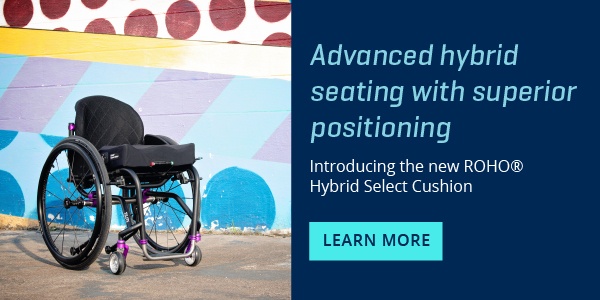Looking for more information on seating and positioning? Check out our digital, rehab-focused Wheelchair Seating & Positioning Guide here.
We've talked before on the Permobil blog about cushion mediums, but in this blog post we're looking a bit closer at the different types of cushion mediums and the benefits and considerations associated with each medium.
Foams Typically used in Cushions
High Resiliency (HR) Foam

- Instantly "springs" back to its original shape post compression
- Durable foam, can withstand repeated compression and maintains resiliency over time
- Provides structure and stability
- Great for use as the base layer of a cushion
Visco Elastic Foam

- Memory foam, meaning it takes time to resume the original shape post compression
- Allows for the most immersion and envelopment, contouring to the unique shape of the user
- Great to use as top layer of a cushion
|
*Density is the measure of quality for foam. A density of 1-3 pounds is considered good for heavy use. What you need to know is, you get what you pay for. When the cost of a cushion seems too good to be true, it is!!! |
Benefits and Considerations of Cushion Mediums
| Benefits | Considerations |
|
Can be designed to be as supportive/contoured as needed |
Foam can be heavy. Consider the weight of the cushion |
|
Can allow for offloading or immersion |
Need to protect the foam from incontinence |
|
Low maintenance |
Most foams inherently retain heat and moisture |
Air
There are different types of air cushions: Individual air cells and air bladders
| Benefits | Considerations |
|
Promote immersion and envelopment of bony prominences, increasing pressure redistribution |
Easily affected by altitude: Higher altitude = firmer |
|
Perceived as “soft” and comfortable |
The softness may affect transfers |
|
Can be adjustable |
May require some maintenance |
Honeycomb
These cushions are made of a thermoplastic material, using a hexagonal honeycomb shape
| Benefits | Considerations |
|
Inherently breathable |
Not adjustable and may not accommodate orthopedic deformities |
|
Lightweight |
Can be perceived as “firm” |
|
Low maintenance |
Not adjustable client balance, endurance, and ROM need to be considered |
Gel/Fluid Inserts
There is a perception that gel is the best medium for skin protection: NOT TRUE!
| Benefits | Considerations |
|
Can allow for immersion of bony prominences for pressure redistribution |
Effectiveness is dependent on the cushion geometry and stability |
|
Some gels state that they are “cooling” to manage microclimate |
Fluid gel can migrate and result in high peak pressures |
|
New gel technology offers solid gel options, eliminating the problem of gel dispersion |
Certain styles require daily maintenance or with every reposition, need to be kneaded and readjusted to provide pressure relief |
|
|
With sun exposure, can retain heat |
Combination
These are a combination of foam and air or foam and gel; style is dependent on the manufacturer
| Benefits | Considerations |
|
Foam provides a stable base for transfers with the skin protection of air/gel |
Can be heavy depending on medium and/or manufacturer |
|
Can allow for immersion and envelopment of bony prominences for increased pressure redistribution |
With well cut outs, the migration of gel or loss of air, can result in the ITs resting on edge of the foam, causing peak pressure |
|
|
May require maintenance to ensure gel packs are in position or air cells are properly inflated |

 Stacey Mullis, OTR/ATP
Stacey Mullis, OTR/ATP
Director of Clinical Marketing
Stacey serves as Director of Clinical Marketing for Permobil. A practicing OTR for over 20 years, she has experience in school-based pediatrics, inpatient rehabilitation, long term care, and home health. With her interest in wheelchair seating and positioning, Stacey engaged the challenges of providing appropriate seating in various clinical settings. She now uses this experience to develop programs and resources to educate clinicians on the principles of seating and wheeled mobility. She is passionate about equipping clinicians and through her previous role as Director of Clinical Education with Comfort Company and now with Permobil she has taught nationally and internationally to increase therapist capacity in this specialty area. Mullis graduated from Western University in London, Ontario, Canada with a BA Linguistics and BSc Occupational Therapy. She is a member of the NCOTA, CTF Executive Board, NRRTs, RESNA, and AOTA.

